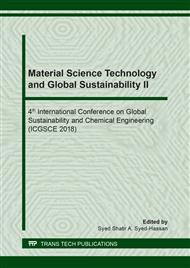p.342
p.351
p.359
p.365
p.375
p.385
p.393
p.402
p.411
Investigation of Corrosion Mechanisms in a Continuous Catalytic Regeneration (CCR) Platformer Unit
Abstract:
— Corrosion is prevalent throughout the world, none less so than in the oil and gas industry. Managing and mitigating corrosion in refining complexes is of paramount importance in order to prevent undesirable consequences such as major fires, explosions and Boiling Liquid Expanding Vapor Explosion (BLEVE) due to Loss of Primary Containment caused by the thinning and ultimate failure of pipelines and vessel walls. Analysis of a platformer unit at a Malaysian refinery has identified the occurrence of thermal fatigue and erosion corrosion on the Vent Gas Tower (VGT) Caustic Circulation line, which in turn has led to the excessive degradation of the walls of a venturi scrubber and the 8’’ caustic circulation line with initial thickness of 12.70mm. The rate of corrosion (0.88 mm/year) of the 8’’ caustic circulation line exceeds the standard allowable carbon steel corrosion rate (0.1 mm/year) as stated in API 571 Damage Mechanisms Affecting Fixed Equipment in the Refining Industry. This indicates that the circulation line has significant potential to fail which would lead to a major HSE incident. Based on these findings it is recommended that the refinery in question modifies the line by increasing the thickness of the line and include a cooling system to reduce temperature swing (ΔT) to below 93°C. Besides that, it is suggested that the implementation of Corrosion-Resistant Alloys (CRA) is conducted on the line. According to ASME B31.3 and supported by ASTM A 193, the line can be replaced with nickel-based alloy, alloy 800H and killed carbon steel which have high resistivity to corrosion than carbon steel. However, more comprehensive studies need to be conducted to identify the viable mitigation methods that are suitable to be implemented on the Vent Gas Tower (VGT) Caustic Circulation line.
Info:
Periodical:
Pages:
393-401
Citation:
Online since:
March 2019
Authors:
Keywords:
Price:
Сopyright:
© 2019 Trans Tech Publications Ltd. All Rights Reserved
Share:
Citation:


